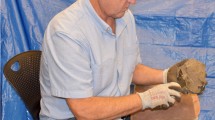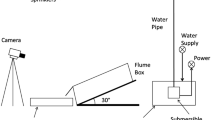Abstract
The way soil is disrupted and deformed by earthworm movement is hard to quantify non-destructively. Two anecic earthworm species, Aporrectodea longa (Ude) and Lumbricus terrestris L., were compared in their effect on the soil around them as they burrow. Image analysis (particle image velocimetry, PIV) was used successfully to quantify the distance and direction of soil particle displacement by earthworm locomotion giving a unique insight into their effect on the soil structure development. The data collected from both species using PIV show a decline in soil displacement at increasing distance from the earthworm’s body. The quantity of soil being displaced was more to the sides of the earthworms (radially) than in front of the prostomium (axially). Also, L. terrestris displaced more soil than A. longa both axially and radially. The findings from this study suggest that PIV image analysis is a viable tool for examining soil displacement by earthworms and the method used has the potential to be applied to other soil organisms.





Similar content being viewed by others
Explore related subjects
Discover the latest articles and news from researchers in related subjects, suggested using machine learning.References
Adrian RJ (2005) Twenty years of particle image velocimetry. Exp Fluids 39:159–169
Bolton PJ, Phillipson J (1976) Burrowing, feeding, egestion and energy budgets of Allolobophora rosea (Savigny) (Lumbricidae). Oecologia (Berl.) 23:225–245
Brown GG (1995) How do earthworms affect microfloral and faunal community diversity? Plant Soil 170:209–231
Buck C, Langmaack M, Schrader S (2000) Influence of mulch and soil compaction on earthworm cast properties. J Appl Soil Ecol 14:223–229
Capowiez Y, Pierret A, Moran CJ (2003) Characterization of the three-dimensional structure of earthworm burrow systems using image analysis and mathematical morphology. Biol Fertil Soils 38:301–310
Darwin CR (1881) The formation of vegetable mould through the action of worms, with observations on their habits. Murray, London, pp 93–94
Dexter AR (1987) Compression of soil around roots. Plant Soil 97:401–406
Dorgan KM, Jumars PA, Johnson BD, Boudreau BP (2006) Macrofaunal burrowing: the medium is the message. Oceanogr Mar Biol Annu Rev 44:85–121
Drucker EG, Lauder GV (1999) Locomotor forces on a swimming fish: three-dimensional vortex wake dynamics quantified using digital particle image veolcimetry. J Exp Biol 202:2393–2412
Edwards CA, Lofty JR (1978) The influence of arthropods and earthworms upon root growth of direct drilled cereals. J Appl Ecol 15:789–795
Edwards WM, Shipitalo MJ (1998) Consequences of earthworms in agricultural soils: aggregation and porosity. In: Edwards CA (ed) Earthworm ecology. St. Lucie, Boca Raton, pp 147–161
Ehlers W, Klipke U, Hesse F, Bohm W (1983) Penetration resistance and root growth of oats in tilled and untilled loess soil. Soil Till Res 3:26l–275l
Grant I, Liu A (1990) Directional ambiguity resolution in paticle image velocimetry by pulse tagging. Exp Fluids 10:71–76
Hendenström A, Van Grienthuijen L, Rosén M, Spedding GR (2006) Vortex wakes of birds: recent developments using digital particle image velocimetry in a wind tunnel. J Animal Biol 56:535–549
Hamilton WE, Dindal DL (1989) Impact of landspread sewage sludge and earthworm introduction on established earthworms and soil structure. Biol Fertil Soils 8:160–165
Jégou D, Hallaire V, Cluzeau D, Tréhen P (1999) Characterization of the burrow system of the earthworm Lumbricus terrestris and Aporrectodea giardi using X-ray computed tomography and image analysis. Biol Fertil Soils 29:314–318
Keudel M, Schrader S (1999) Axial and radial pressure exerted by earthworms of different ecological groups. Biol Fertil Soils 29:262–269
Langmaack M, Schrader S, Rapp-Bernhardt U, Kotkze K (1997) Quantitative analysis of earthworm burrow systems with respect to biological soil-structure regeneration after soil compaction. Biol Fertil Soils 28:219–229
McKenzie BM, Dexter AR (1988a) Axial pressure generated by the earthworm Aporrectodea rosea. Biol Fertil Soils 5:323–327
McKenzie BM, Dexter AR (1988b) Radial pressure generated by the earthworm Aporrectodea rosea. Biol Fertil Soils 5:328–332
Newell GE (1950) The role of the coelomic fluid on the movement of earthworms. J Exp Biol 27:110–122
Quillin KJ (2000) Ontogenetic scaling of burrowing forces in the earthworm Lumbricus terrestris. J Exp Biol 203:2757–2770
Schrader S (1993) Semi-automatic image analysis of earthworm activity in 2D soil sections. Geoderma 56:257–264
Schrader S, Rogasik H, Onasch I, Jégou D (2007) Assessment of soil structural differentiation around earthworm burrows by means of X-ray computer tomography and scanning electron microscopy. Geoderma 137:378–387
Sims RW, Gerard BM (1985) Earthworms: key and notes for the identification of the species. In: Brill EJ, Backhuys W (eds) Synopses of the British fauna (new series) no 31. Linnean Society of London, London, pp 62–64 106–108
Mathworks (2000) Using Matlab, the language of technical computing, computation, visualization, and programming, version 6. The Mathworks, Natick
White DJ, Take WA, Bolton MD (2001) Measuring soil deformation in geotechnical models using digital images and PIV analysis. Proceeding of the 10th International Conference on Computer Methods and Advances in Geomechanics, Tucson Arizona, pp 997–1002
White DJ, Take WA, Bolton MD (2003) Soil deformation measurement using particle image velocimetry (PIV) and photogrammetry. Géotechique 53:619–631
Yapp WB (1956) Locomotion of worms. Nature 177:614–615
Acknowledgements
We thank David White and Andy Take for access to the University of Cambridge PIV code and Stephen Hobson for help using the Matlab programme. We also thank Christine Hackett (Biomathematics and Statistics Scotland) for statistical advice. The Scottish Crop Research Institute receives grant-in-aid support from the Scottish Government Rural and Environment Research and Analysis Directorate.
Author information
Authors and Affiliations
Corresponding author
Rights and permissions
About this article
Cite this article
Barnett, C.M., Bengough, A.G. & McKenzie, B.M. Quantitative image analysis of earthworm-mediated soil displacement. Biol Fertil Soils 45, 821–828 (2009). https://doi.org/10.1007/s00374-009-0392-9
Received:
Revised:
Accepted:
Published:
Issue Date:
DOI: https://doi.org/10.1007/s00374-009-0392-9




